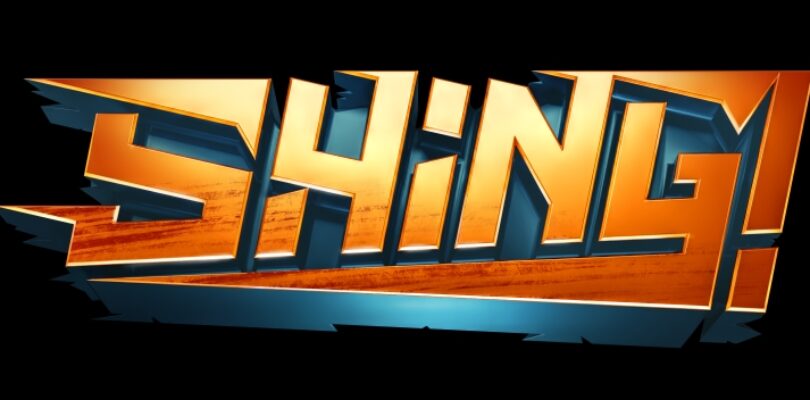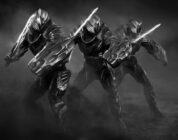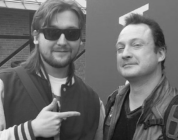The Settled Down statuette of this year’s Digital Dragons was awarded to Shing! by Mass Creation. The Warsaw-based studio is behind such titles as Draw Slasher and Corridor Z.
Shing! is an exciting 3D beat ’em up with pocketfuls of retro inspirations. It stole the hear of this editor primarily because it was almost immediately obvious that the authors love the genre and thought intensely on how to breathe some life into it.

Our questions were answered by:
Grzegorz Kurek
Game Director at Mass Creation
Game Director with art and animation background and 10 years of game development experience. An avid gamer since the Commodore 64 and Amiga days. Started his career in college, working as a cartoonist for PSX Extreme, one of Poland’s biggest gaming magazines. A member of Mass Creation since its conception, he co-created most of its games’ design and art. Responsible for action-arcade games like Run Like Hell!, Draw Slasher and CorridorZ, he has experience in developing for mobile, consoles and PC. Currently working hard with the Mass Creation team on “Shing!”, making it the next big thing in the beat ’em up genre.
Andrzej Sugier
Game Designer at Mass Creation
Game designer, graphic artist and animator with background in IT. Involved in the video game industry since college – creating games in tiny independent teams, freelancing, working at both small and major studios. A member of the Mass Creation team since 2017.
Let’s start with Shing! itself. The first thing that truly stood out to me were the controls based on „gestures” made with the analog stick. Personally, I was very happy that this isn’t another game where I’m pressing triangle and square. How did this idea, closer to Capcom’s fighting games, come about? Was this always the plan for the game’s „core”, or was it a result of experimentation?
Grzesiek: This was the very first solution w came up with then trying to find a way to transplant the mechanics of „Draw Slasher” onto a gamepad, since Shing! initially was a sequel. After a couple iterations we ended up with a system that was very pleasant to play with and easy to learn. It quickly turned out to give a lot of options, the analog stick allows to perform as many moves as on five different buttons. The input speed of various attacks is much faster than when hitting buttons, especially when creating combos and switching between moves. Additionally, there’s the freedom of slashing, which allows to cut up enemies in any which way you want, just like in Draw Slasher. You want to decapitate, or maybe take out a leg or bisect a demon vertically? This system allows for pretty much anything. Doubts about these controls clicking with people were put to rest during first tests. After expos, we were absolutely sure that we hit the jackpot.
You don’t hide your arcade roots. Which classic beat ‘em up inspired you the most? What did you simply play for the longest time?
Andrzej: My fascination with beat ‘em ups started with Dungeons and Dragons: Shadow Over Mystara and Die Hard Arcade. But a real revolution to me was Shank, which combined everything I love about the genre with the spectacular gameplay of console-style brawlers – juggling enemies in the air, a wide array of weapons and moves, satisfying, varied gameplay.
G: For me it was Golden Axe and Double Dragon, since that’s what I had at home on the Amiga. In arcades, I played the hell out of Cadillacs and Dinosaurs and Alien vs Predator. Then came Nintendo and the Final Fight series. On the PSX, I played Fighting Force with my brother and… that’s it. The remnants of beat ‘em ups were only to be found in Tekken in one of the modes and every now and then some mostly mediocre title came out. The genre just couldn’t handle the transition to 3D. Even back then with Fighting Force you could tell that this isn’t the same anymore. Die Hard Arcade was a total exception, but that game was closer to Shenmue than a sidescroller. I also remember playing a bunch of Namco’s Urban Reign for the PS2, that’s a very underrated game in my opinion. Afterwards, the baton was taken over by Devil May Cry and other slashers, while arcades got taken over by fighting games, with Tekken as king. Arcades themselves largely started to disappear or change profiles to stuff like dancing games.

I miss all those emotions from playing on machines in an actual arcade. I remember my vacations in Władysławowo and how I spent all my pocket cash on Fighting Vipers. I mastered a character in two weeks and reached the last boss. At one point, my brother comes up and tells me that there’s a small crowd behind me. I was at the last boss and was at my last 3 quarters – once I ran out, some guy came up and gave me another 2, then other people. They brought me quarters until I finished. People started to cheer until finally, after two hours I finished off that boss – they almost took the tent down!
I’m often annoyed by balance in indie beat ‘em ups – like Mother Russia Bleeds. Some of them play as if the authors still expect us to put money in. Who is your target? Hardcore players, or casuals? How deep can you dive into the combat?
A: We want the game to reach both casuals players who just want to play with friends over a beer and to those players who want to bite into a combat system and test out its limits. It’s why we’re going for a similar ideal as Devil May Cry or Bayonetta, where finishing a level is something most players will accomplish with relative ease – the real test of skill is completing a section making spectacular combos and not getting hit.
G: There’s a couple of hidden mechanics and systems. Finding out ways to quickly finish off a mini boss during a repeat playthrough gives a lot of satisfaction. You’re supposed to feel like a badass playing Shing!, but not at the expense of challenge. The best rewards are those you earn and let’s keep it that way. The ridiculous difficulty in these games was indeed mostly there to take your quarters, but it had a certain boon to it – you were looking for the most optimal solution. Although that usually ended up to be repeating the same dash kick, which wasn’t very fun. In Shing! we took a different path, the enemies are varied and the combat system is complicated enough that one style is not enough. You have to search for your best opportunities that also fit your style of play and juggle betwen those on the fly. When you finally get those techniques and learn the enemies, that’s when you can go about mastering the level.
Stylish combat in co-operation – with combos and juggling – has been largely unexplored. Is Shing! a primarily co-op game, or will a single player find just as much fun?
G: We have something for that. In the game, you can change characters on the fly and it happens fast enough that it’s a part of the combat in itself. You can cancel moves, prolong a combo or save power ups for later. This additional layer is replaced by co-op action when another player jumps in, since other characters are unavailable. The game’s four characters are always available and they are part of the plot, which lets us make it a bit more expansive than in your typical beat ‘em up. For a single player there are also other attractions, such as challenges or lore rooms (locations where you can learn more about the characters and the world). The characters are sort of like 4 lives, the game over screen only happens when all of them are out, and they can heal each other by trading health. Character management will be something that a lone player will appreciate much more.
Finishing up the matter of genre… How do you think: where are arcade games going, particularly brawlers? Is there a beat ‘em up renaissance around the corner, or this type of action games will simply fade in and out with one or two exceptional titles?
G: It’s hard to say. Arcade games are coming out constantly, but they get drowned in a flood of very different titles. It’s good that publishers such as Devolver keep the genre alive. Making a good brawler is neither cheap nor easy. It’s a genre that simply aged, which is why it’s so hard to save its most characteristic traits, yet keep up to contemporary gameplay or visual standards. It’s a real puzzle to figure out 2D combat while moving in three dimensions: from setting up the camera in a particular position, through cheating the perspective to a specific way of animating. It would be easier to make a TPP game, or an isometric one.
A: I think that beat ‘em ups will always be a niche genre, but one that’s always present. They work perfectly for any sort of couch co-op situation thanks to several traits which, at the same time, dampen their appeal for a larger public.

You can learn to play a good beat ‘em up in a couple of minutes and immediately have fun – at the same time, genre classics offer deep enough combat so that players have something to discover for the rest of the game. However, the skill gap between an experienced player and a newbie can’t be too wide – a new player can’t ever feel useless. This sets a certain border, behind which deeper, more mechanically complicated beat ‘em ups simply become worse and worse examples of the genre. Suddenly a new player, instead of feeling like an unstoppable beast, feels that they’re worse than their friend – who knows the combos, has a higher level character or unlocked more skills.
Similarly, the game has to be challenging enough to enforce cooperation, but it can’t ask you to fully understand every single mechanic – at least some of the players will be newbies. A perfect beat ‘em up stays in this niche between casual and hardcore games.
Finally, the length – you can finish your ideal beat ‘em up in one or two evenings. Most of us don’t meet friends often enough to play through a game that’s a dozen hours long. And dropping a game we liked is never pleasant.
Still, iin the end: exciting, intuitive co-op games are a perfect mixture for social gatherings. So a good beat ‘em will always find a place and purpose.
Is storytelling important to you? Or are you primarily about that action? What do you look for in games yourselves?
A: Personally, gameplay is what’s most important to me. It differentiates games from other media – it lets us breach the barrier between a story’s protagonist and the passive observer. Still, a good story is super important. It’s like spices, a multiplier, it makes good games outstanding.
Storytelling in co-op games is not an easy task. In a group, a decisive majority of players skip cut-scenes, they don’t read dialogues, they want to get back in the action as fast as possible. This is why we went for tried and true solutions from i.e. BioWare’s games – instead of telling complex stories, we focused on creating interesting characters and exploring their relationships without stopping gameplay. During gameplay, the characters exchange stories, joke around, comment on their surroundings. Every dialogue is a small tale. This sort of „episodic” way of storytelling works great in those games in which many players only occassionally pay attention to the plot and don’t want to stop the gameplay for it.
For players who’d like to dive into the world of Shing! We prepared optional dialogue rooms – locations where the characters take a breather and talk at length, so the player can learn more about them and their world.
G: In accordance with „show don’t tell”, the story is often told through visuals. The environments aren’t just window dressing, they talk a lot about the world and a perceptive player will get a lot from them. It’s another nod to those players that will stick with the game in single player and sink their teeth in its layers.

Shing! features Asian motifs, some light neons… It’s „your” aesthetic, or something that came alongside crafting the mechanics?
G: The aesthetics are the natural endpoint of the styles of ‘90s arcade games. Ninjas, demons, neons are references to what was popular back then. The world of Shing! Is very varied, so all the levels differ from one another.
The everpresent blue substance in the world of Shing! is called essence. It’s a mysterious liquid which produces a ton of energy and has different properties depending on its state of matter. This idea came about so that the characters and enemies’ special powers had some in-universe explanation and didn’t come out of nowhere. But the neons, machines and other elements also exist because of essence.
Until now, you focused on simpler games for mobiles and handhelds. Are games of Shing’s! scale the new direction for Mass Creation, or can we expect more smaller titles?
G: Making small games is fast and pleasant, but you need a really solid idea. Corridor Z seemed super weird, yet it clicked. Same thing with Draw Slasher. If we ever come up with another cool, small idea – sure, why not, we’ll put it out. But I personally already dream of making another brawler, the ideas are all here, so is the technology.
Draw Slasher utilized the Vita’s capabilities, which can’t be said about every game released for this unique handheld. Do you miss the console? Do you hope Sony will take another crack at handhelds?
G: Vita became my machine for PSX emulation. I have a large library of old jRPGs I like to come back to every now and then. Suikodens, Vagrant Story, Alundra – these are the games I launch the console for. I don’t know what Sony’s planning, but the Big N is the king of handhelds and I think it’ll stay that way. The Switch is so good that I doubt anyone will try to get into the market in the nearest future.
A: Personally, due to my ginormous backlog, I’m still playing those PSP games I’ve missed – so my adventure with the Vita is not over still. I expect a handheld renaissance. Because of smartphones, an incredible number of people realized how much fun a handheld console can pack. The mobile market is specific enough that it’s doubtful it’ll ever replace handhelds – I think that’s one of the reasons for the Switch’s massive success.

Finally: how do you see a „Settled Down Gamer”? Do any of you feel like one?
A: Personally, I don’t feel like a settled down gamer – although I’ve been playing games since basically forever, my fascination with them has never dampened. I regularly discover new genres that I wouldn’t get into a few years ago, but now take over my attention. Thanks to emulation, I discover gems from the past that could easily compete with new, big budget titles. I get into more and more e-sport scenes. I still feel like I’m at the beginning of a great journey!
G: Does a wife, a daughter and a mortgage count? I have much less time for games than I used to. Pulling all-night raids in Destiny is not for me anymore. I pick my games carefully, I don’t really experiment – I’m this gaming conservative. I invest my time in certified bangers and sometimes visit older titles, especially those for Amiga or PSX. I like a good story and challenging gameplay, serials like Assassin’s Creed or Call of Duty just don’t do it for me like they did; and while I get the e-sport phenomenon, I am just completely not into it. I settled down as a gamer in the same moment I settled down as a man. Yes, I’m a Settled Down Gamer.





